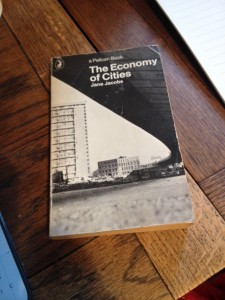The past week I was in West Wales with next to no connectivity, so it was a good week for reading but not for blogging. One of the books I read was the new paperback of Eric Schlosser’s [amazon_link id=”0141037911″ target=”_blank” ]Command and Control[/amazon_link].
[amazon_image id=”0141037911″ link=”true” target=”_blank” size=”medium” ]Command and Control[/amazon_image]
It’s the story of America’s nuclear weapons; not so much the diplomacy and strategy of the Cold War, although there’s a bit of that for background, but rather how many accidents there have been. It’s a terrifying book because of the sheer number of explosions and leaks, and it seems only luck that has prevented there being a more serious disaster. And then it’s doubly terrifying when you close it and realise that this was the US only, and there are plenty of other countries with nukes, including a number with far less sophisticated scientists and management systems. Heaven only knows how many accidents there have been involving warheads in the USSR or North Korea, or what’s rattling around the FSU countries now. Still, as Schlosser points out, of the 70,000 nuclear warheads (70,000!!!) built by the US since 1945, none has detonated by accident or without proper authorization. “The technological and administrative controls on those weapons have worked.”
Having nuclear weapons involves one central dilemma, Schlosser explains. There is an engineering trade-off between making them ultra-safe to store and transport, and making them work every time if they need to be fired – because the whole logic of deterrence depends on there not being any dud ICBMs. The complexity of the weapons and the safety procedures developed around them – albeit often ignored by maintenance teams – also militates against the strict command and control hierarchy of the military. You can see why the top brass insisted that all instructions in case of accident had to come from them. After all, it seems mad to allow any improvisation where nuclear warheads are concerned. However, in a fast-moving, confused, uncertain environment when a serious accident is under way and an explosion could detonate a warhead, it also seems mad not to allow the men on the ground to make their own decisions – especially in the pre-web, pre-mobile days when communications from command posts were slow, and easily disrupted. Nuclear weaponry is really the opposite of the kind of engineering project described in Tim Harford’s [amazon_link id=”0349121516″ target=”_blank” ]Adapt[/amazon_link]. He argues that freedom to fail is a vital part of successful innovation. You don’t want freedom to fail when it comes to the H-bomb.
[amazon_link id=”0141037911″ target=”_blank” ]Command and Control[/amazon_link] has lots of fascinating detail. One bit I enjoyed was that the underground bunker created in Britain (described in Peter Hennessey’s [amazon_link id=”0141044691″ target=”_blank” ]The Secret State[/amazon_link] as well) had accommodation, a gold vault for the Bank of England’s reserves, a BBC studio – and a pub called the Rose and Crown. I will certainly follow up the reference to an article by Langdon Winner, ‘Do Artifacts Have Politics?’, which apparently asks whether certain technologies can only operate in specific political contexts:
[amazon_image id=”B00IO95SS8″ link=”true” target=”_blank” size=”medium” ]The Secret State: Preparing For The Worst 1945 – 2010[/amazon_image]
So, overall, C&C is a gripping read, but I want to carp as well. Schlosser is a terrific writer, but this book really needed an editor. No character, no matter how minor, is introduced without his cv. There is so much technical detail that it derails the story. Most bizarrely, there is one particular accident that starts and ends the book, such an edge-of-the-seat tale that I’m sure Hollywood is already working on the film – but rather than simply presenting it as the opening and closing chapters, framing the meat of the book, it is woven in throughout the other chapters, and pops up at seemingly random points.
Still, well worth reading, and go and see the movie when it’s out, too.

